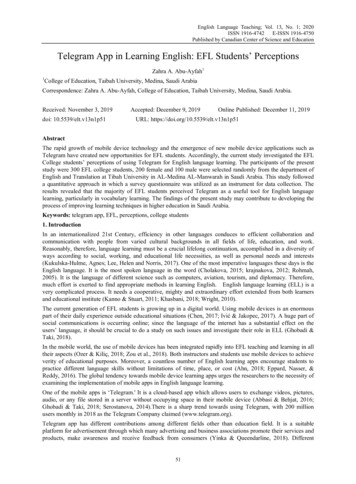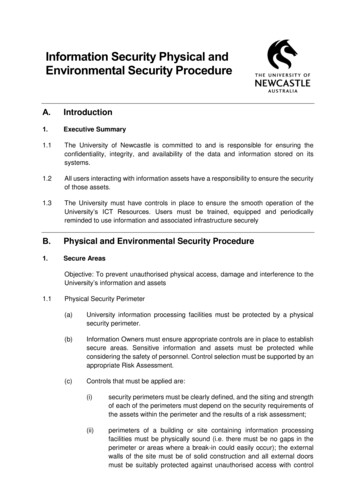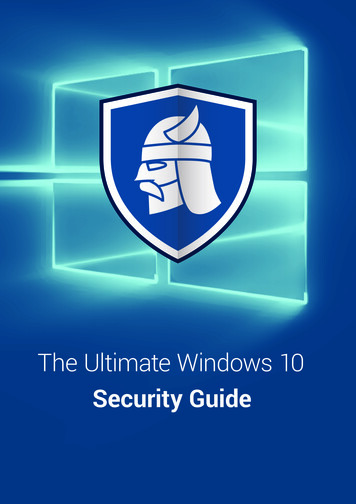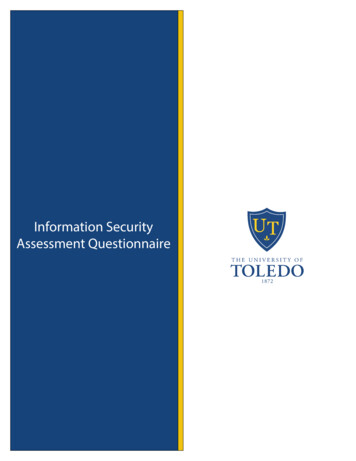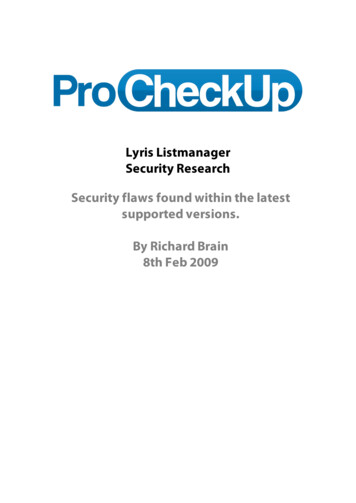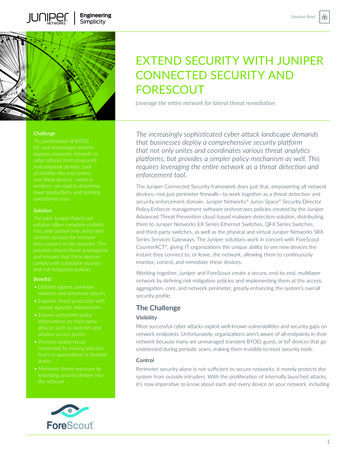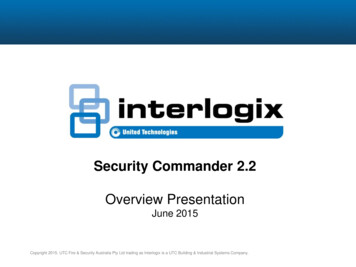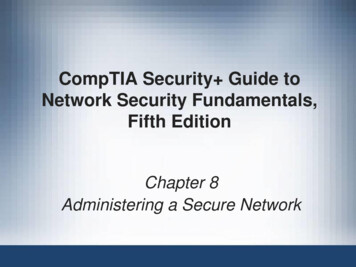
Transcription
Security Analysis of Telegram6.857 Final ProjectHayk Saribekyan (hayks@mit.edu)Akaki Margvelashvili (margvela@mit.edu)May 18, 2017AbstractTelegram is an instant text messaging platform, with a secure messaging protocol called MTProto. The company was founded in 2013and has more than 100 million active users. Telegram was createdto allow users to have surveillance-proof communication. It claims tohave the best security and privacy guarantees in the market. In thisreport we overview Telegram, discuss its protocol and compare it tosimilar products. We also exploit a leak on user availability and useit to predict when users are talking to each other.1IntroductionIn the past decade, as more and more people got access to the internet, instant messaging services have thrived. As of May 2017, two of the top fivemost downloaded applications on Android market are messaging services [1].In recent years the users of communication tools, including messaging services, have become more conscious about the privacy and security concerts.To suit the users’ needs better, many platforms started offering end-to-endencryption [2, 3]. WhatsApp1 , for example, introduced end-to-end encryption three years ago and as of now it is enabled for all its communications. Ithas the largest user base that has end-to-end encryption enabled for everyone.Among many messaging services is Telegram, which has been founded in2013. Despite being a newcomer to the field, it has more than 100 million1Which, by the way, is down at the time of writing :)1
monthly users, especially in Eastern Europe. Telegram claims to have thebest security and privacy guarantees among similar products, but relies onthe users to trust it by the virtue of its history and talent. For our project, wewould like to perform a security analysis of Telegram [4], as it has come under heavy fire from many professional cryptographers due to its unorthodoxdecisions in development.In this section, we will discuss Telegram’s history and user interface. Section ? describes Telegram’s system design; Section 3 contains previouslyknown issues with Telegram; Sections 4 and 5 discuss a privacy vulnerability that Telegram exposes. In Section 6 we reflect on Telegram and drawconclusions.1.1History and BackgroundTelegram’s history is unique among tech stratups and we believe that itgained much attention, trust and user base thanks to that. So it is worth tomention the history as a background.Telegram was founded in 2013 by brothers Nikolai and Pavel Durov, whowas also the founders of a popular Russian social network VK. After pressurefrom the Russian government to hand over backdoors Durov left the companyand claimed that VK is under control of the political party in power [5]. Hethen left Russia and founded Telegram, aiming to provide surveillance-proofmessaging to non-tech-savvy users.Thanks to Pavel Durov’s popularity in Russia, Telegram quickly gainedground among Russian-speaking community. Moreover, Telegram arguablyprovides one of the best user experiences compared to similar products thanksto its speed and functionality.Telegram’s messaging protocol is developed by Pavel’s brother Nikolai,who is a mathematician, but is not known as a security expert.Telegram is unique among tech startups in that its solve funding sourceis the founder Pavel Durov. It does not use adds anywhere on its platformand the clients are not only free, but also open-source.1.2Telegram FunctionalityTelegram allows users to send instant messages, voice messages and communicate in groups. It also has ’channels’, to which users can subscribe and2
receive broadcast messages by the creator of the channel (usually a newswebsite or a celebrity).Telegram has a ’secret chat’ feature, which is not enabled by default. Thesecret chats are Telegram’s version of end-to-end encryption. The messagesare destroyed after a time limit set by the user and should not recoverable.Telegram has chosen to not make messages end-to-end encrypted by defaultto enhance user experience: secret chats are bound to specific devices andit is impossible to continue a conversation on a device it was not startedon. We do not believe that this is acceptable as many non-tech-savvy usersassume that no one can ever access their messages, when in fact they trustthe server for the security.Users in Telegram have to create and authenticate their accounts usingan authentication code received by text messages. After the initial authentication, the users can set handles and find each other using those. Telegramalso has a two-step verification mechanism for which the user has to enter apassword every time s/he authenticates.1.3Telegram ClientsTelegram has clients for all popular platforms including web applications.Figure 1 shows Telegram’s clients for Android and Desktop. The officialclients are open-source though they have binary blobs i.e. executable binarieswithout publicly available codes.Telegram even has a command line interface [6], which provides almostfull functionality of the messaging platform albeit it is not as user-friendly.For example, to add a contact one has to write in the interfacetg add contact phone number name lastname We have extensively used the command line interface during this project.2Telegram ArchitectureLike many of its competitors Telegram follows a conventional approach ofusing a cloud storage for its data. This means that if an adversary is ableto gain control of their server system, they will have access to (at least)unencrypted messages and definitely to all the metadata. The messagesbetween users and the server are passed according to Telegram’s home-grownMTProto messaging protocol.3
Figure 1: Official Telegram clients. Left: mobile client, right: desktop client.All official Telegram clients are open-source. Telegram provides noticeablefaster and smoother user experience.The users use a Diffie-Hellman key exchange to generate a common keythat is then used to pass messages. They communicate with the server usingthe server’s public RSA key, which is hard-coded in the Telegram clients andchanges rarely.Telegram is using home-grown MTProto protocol, that circumvents manytraditional approaches for messaging passing. Telegram claims that thisis done for its superior performance, although many security experts havedoubts about the claims.3Known and Fixed Security ConcernsJust like any other tech company, Telegram had, has and will have bugs,security issues and in general security-related issues that are unorthodox inthe community. We are presenting some of them here. In next sections wewill focus on one of them.3.1Non-technical concernsOn a conceptual level, Telegram has some non-standard practices that webelieve should not be part of a secure protocol. Namely:4
Telegram’s end-to-end encryption feature is not enabled by default onthe application [7]. For this reason, lots of the users who don’t haveenough expertise on security/encryption end up using the Telegramwithout ’secret chat’ feature thinking their messages are encrypted.Without secret chats, the users have to trust Telegram servers. Telegram uses a home-grown cryptographic protocol called MTProto,a decision which has been heavily criticized; common security doctrine dictates that developers should never ”roll their own” crypto, andshould leave cryptographic protocol design to the experts. Those whohave examined the protocol themselves have also come away skeptical;cryptographer Matt Green commented that ”Telegram is ten millionrube goldbergian moving parts, all put there to support a single, unauthenticated Diffie-Hellman key exchange.” [8] Telegram initially asks for the contact list from the phone/desktopand stores them in their servers. This provides huge social networkinformation for them that either be attacked on their servers or canbe possibly sold to different authorities without users’ consent. This isanother case when the users have to trust Telegram with their data.3.2Technical security issues A team of researchers in 2015 announced a man-in-the-middle attackon Telegram that could maybe have been feasible for a nation-stateadversary. The attack involves generating Diffie-Hellman shared secretsfor the two victims which have the same 128-bit visual fingerprint, sothat users who compare fingerprints will be unable to detect the attack;using a birthday attack, this only requires 26̂4 operations. Telegramhas since increased the number of fingerprint bits significantly, but thefact that this vulnerability was ever present is still worrying, since itwas an error that experts should not make. In order to verify eachothers’ keys and prevent MITM attacks, users must visually comparegrids of squares in four shades of blue; this introduces a lot of potentialfor human error, and users might not notice subtle differences betweentwo grids, or might not be willing to deal with the hassle of comparingthe grids in the first place.5
Until 2014 Telegram’s MTProto was using a modified version of a DiffieHellman key exchange [9]. Instead of using the key generated by theusual DH protocol, the server would send the users the key XORedwith a nonce. This would allow an evil server to use different noncevariables for the two users. As a result, the users would still havethe same key, but it would also be known to the server. Once again,the users had to trust the Telegram server. To their credit Telegramhas solved this issue, but just its presence raises questions about theircommitment to security, because the issue is a very simple one. Telegram uses SHA-1 instead of SHA-256 for hashing in some partsof its protocol. It is known that SHA-1 is not collision-resistant [10].Even if Telegram, as it claims, is using SHA-1 at a place where it isnot essential to have collision-resistance, using a stronger hash functionwould be more reasonable. As history has proved many times, bugs andmissed cases are common. Even while using the ’secure chat’ to communicate, Telegram’s mobile application makes it possible for the third parties to observe themetadata information. For example, adversaries can learn when usersgo online or offline with down-to-the-second accuracy. Telegram doesnot require agreement from the both parties to set up the communication between them. For this reason, an attacker might connect tothe user and they will receive the metadata information without theuser knowing anything about this. For this reason, the attacker mighthave a good chance of guessing if 2 users communicate by connectingto both of them and observing their app usage metadata. We call thisan availability leak and will discuss it further in sections 4 and 5.As the previous examples show, in many instances Telegram users shouldcompletely trust the server, which is ironic as the founders claim was thatthey wanted to provide service that is surveillance-proof. Even though manyof the security issues were fixed, some of them should not have been there inthe first place.4Availability ExploitAs it was briefly mentioned in previous sections, Telegram exposes the users’availability data to anyone who has their phone number. Suppose Eve adds6
Alice as a contact. The Telegram protocol in this case does not notify Aliceabout it. Eve, however, gets a response from Telegram whether Alice isusing the service, and if so Eve starts receiving notifications about Alice’savailability. At no time Alice receives any notification.Figure 2: The Telegram CLI outputs the user’s name if he/she is using it,but stay silent if not.This availability leak is easily visible in the Telegram command line interface (Telegram CLI). Figure 2 shows that using the CLI Eve can tell whetherAkaki is using the application or no.Moreover, Figure 3 shows that Eve can see when Akaki and Hayk arebecoming available and going offline. She can then correlate the time intervalswhen both are online and conclude that they converse. In the next sectionswe describe how exactly this exploit can be used to detect if a pair of usersare talking to each other.4.1Experiment SetupWe have chosen 15 active Telegram users to track their application usage andcommunication. The pool of the users were chosen from the well connectedinternational students at MIT. This way we knew that they communicatedusing telegram on daily/weekly basis.We have used Telegram command line CLI client to connect to the users.The server has been deployed that was listening for those 15 users’ packetsand was gathering the metadata for more than 2 weeks. This way, we havegathered several megabytes of the raw metadata to be analyzed.4.2Correlation AlgorithmWe have designed a correlation algorithm that takes Telegram usage information of 2 users and outputs a sequence of the matches were each match7
Figure 3: Eve is watching Hayk and Akaki, and can tell when each personbecomes available. Notice a bug: the ”going offline” times are 5 minutes off.represents time interval with the probability that users were talking in thattime interval (reported probability is always at least 0.5). From the gatheredmetadata, for each user, we created a timeline that shows its activity intervals sorted by time. Algorithm finds matchings of 2 users talking based ontheir timelines.Figure 4: Diagram illustrating the main concepts of Correlation algorithm.We say that active time intervals of Alice and Bob respectively are connected (purple arrow on Figure 2 ) if these time intervals intersect in gap time.It means that 2 time intervals that have 2 points respectively that are maximum gap time far away from each other are said to be connected. We doit because, it takes time for the user to open the application after he/shereceives a message.8
Now, by looking at each of the active time interval as a vertex and each ofthe connections as an edge we get a bipartite graph. In this bipartite graphwe look for the connected components that has at least 1 edge in it. If we sortthe active time intervals in the connected component, we will see the chainof overlapping usages of the Telegram application by Alice and Bob. Everyconnected pair of time intervals indicates a reasonable probability of the 2users chatting that time. However, when we have a chain of connected intervals it significantly decreases the chance of Alice and Bob not communicatingwith each other.Each connected component represents a separate possible communication(set of messages exchanged in relatively short time of period) between theusers. Since the user might leave the Telegram application open (therefore,no metadata information is delivered that time), we do not take into theconsideration the size of the active time interval. Rather, we believe thatnumber of the active time intervals is the most important because user goingoffline and coming online frequently means that he/she is actively engagedin using Telegram.We define a likelihood coefficient to be a measure of how highly likely itis that a connected component represents an actual communication betweenthe users. Note that, an edge in the connected component coming from anactive time interval that is connected with many other vertices should beless influential than an edge whose end points are not connected with anyother intervals. For this reason, rather than counting number of edges inthe connected component, we define likelihood coefficient to be one half ofall the connected vertexes in the component. This way, a very long activetime interval that overlaps lots of other intervals does not increase likelihoodcoefficient significantly.Once we calculate a likelihood coefficient, we define a probability of 2users talking during the span of time in the specific connected componentby:Ptexting 1 2 α coef f icientThe idea is that if the likelihood coefficient is 0, then Ptexting 0. However, on every unit added to the coefficient, the probability of not communicating decreases by half. A multiplier α adjusts how smooth or stiff the theinfluence of the likelihood coefficient should be.9
5Results from Availability ExploitWe implemented the algorithm described above and ran it on the parsedmetadata gathered by our server. Since both of us have been using Telegramwhile the server has been running, we adjusted parameters by looking at ourconversations and checking the correctness.We have found that setting the gap time to 30 seconds and setting α 1was giving a reasonable results that was catching all the communications andalso was not slicing the actual conversations too much. The results showedthat around 15% of all the found matchings were false positives. In otherwords, sometimes when 2 users happen to use the application at the sametime makes an algorithm to be tricked.6ConclusionIn this project we have surveyed the Telegram messenger. When Telegramhas started as a company it became popular because of its claims, public’strust in the founders and also the timing (NSA leaks by Snowden were happened in the same year). Given these claims one would expect very high levelof security from Telegram. However, our survey shows that Telegram has hadserious and simple issues in the protocol (e.g. modified buggy Diffie-Hellmankey exchange) that any knowledgeable security expert could penetrate.By using the command line interface of Telegram we have been able tosnoop on some of our friends and detect the times when they were conversingto each other. We believe that this is a serious privacy issue, because it canbe exploited to detect relationships in classroom for example.Finally, our conclusion is that Telegram, just like any other applicationhas vulnerabilities. Users have to be aware of this fact, but unfortunatelythe claims by companies make non-tech-savvy users to believe that theirmessages are unreadable by third parties.References[1] Android market app ranklist. http://www.androidrank.org/. Accessed: 2017-05-16.10
[2] Secret conversations in facebook. 3321594605. Accessed: 2017-05-16.[3] End-to-end encryption (whatsapp). https://www.whatsapp.com/faq/en/general/28030015. Accessed: 2017-05-16.[4] Telegram. telegram.org. Accessed: 2017-05-16.[5] Vkontakte founder pavel durov learns he’s been fired through media.Accessed: 2017-05-16.[6] Telegram messenger cli. https://github.com/vysheng/tg. Accessed:2017-05-16.[7] perational-telegram-cbbaadb9013a. Accessed: 2017-05-16.[8] Matt green on twitter about telegram.https://twitter.com/matthew d green/status/582916365750669312. Accessed: 2017-0516.[9] Is telegram secure (russian). https://habrahabr.ru/post/206900/.Accessed: 2017-05-16.[10] Shattered. https://shattered.io. Accessed: 2017-05-16.11
Figure 5: Matchings found by the correlation algorithm.Figure 6: Corresponding messages to 5. The second to last matching corresponds to the messages in the application (time 23:31 - 23:35)12
Security Analysis of Telegram 6.857 Final Project Hayk Saribekyan (hayks@mit.edu) Akaki Margvelashvili (margvela@mit.edu) May 18, 2017 Abstract Telegram is an instant text messaging platform, with a secure mes-saging protocol called MTProto. The company was founded in 2013 and has
